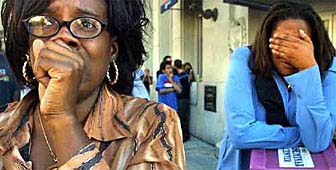Pictures of a wounded city exhibited in Lausanne

Perhaps the most stunning - and disturbing - documented images yet seen of New York since September 11 are on show in Lausanne.
Over 200 images have been chosen by the Musée de l’Elysée photography museum to represent a defining moment in history and its aftermath in one of the world’s most photographed cities.
Entitled “New York after New York – Photographs from a Wounded City”, the exhibition depicts fear, panic, grief, death and destruction, in scene after scene of a tragedy which in many ways has left permanent scars.
Not surprisingly, it was no easy task for museum director William Ewing and his colleagues to illuminate the roles played by photography as a “window” through which the events can be observed.
“For months my New York friends, and there are many of them because I lived there for 15 years, were reticent about doing something more than just talking about it,” says Ewing. “The talk was pessimistic and there was a reluctance to do anything in terms of a major project.
Politically incorrect
“I felt that with the distance of being in Europe, we could say things that would be construed as politically incorrect over there. It was that psychological distance which enabled us to have a freer hand.”
New York has one of the world’s highest concentrations of news and photographic agencies. But the Lausanne exhibition is by no means restricted to the work of photojournalists – there was a wealth of other material from which to choose.
As a museum, the Musée de l’Elysée had access to a network of photographers whose images had not previously appeared. During and after September 11, some professionals specialising for example in studio portraits, found themselves working more as war photographers.
“The irony is that New York is the capital of the image world and was therefore able to respond to an attack on its person,” Ewing told swissinfo. “A few days ago, a military metaphor occurred to me. It was almost as if an army of photographers was in position and up close. They all responded, wherever they were.”
Victim’s last images
Two photographs bear witness to the dangers many of them faced. They were the last images taken by Bill Biggart before he was killed in the immediate aftermath of the attacks.
As Ewing puts it, hundreds of photographers – amateur and professional — documented the catastrophe with striking images: the apocalyptic visions of crumbling towers and the exodus of shocked, dust-covered people emerging from the site were scenes which might have been plucked straight from Hollywood.
Video cameras captured the sudden, brutal impact of the planes crashing into the Twin Towers, but it was the still photographs which froze each instant in chilling detail.
Ewing and his colleagues made their final choice after considering many thousands of pictures, and the exhibition reveals much of what had been missed by the video cameras.
Aside from photojournalists and commercial photographers, independent photographers – and artists who use cameras – added their voices to the record.
The Twin Towers had long been a subject of interest to such photographers. Some of these images, created before September 11, display elements of doubt, even anxious premonitions of danger. And images created after the event provides material for wider contemplation.
Says Ewing: “Among the most powerful pictures are of people returning to work at the stock exchange. There’s a vacancy in their facial expressions which is something you rarely see in New York.
“Our scope is that of a museum of photography. Our interest is not primarily the events of September 11, but how those events were reflected or mirrored in photographs.”
The exhibition is at the Musée de l’Elysée until September 16.
by Richard Dawson

In compliance with the JTI standards
More: SWI swissinfo.ch certified by the Journalism Trust Initiative
You can find an overview of ongoing debates with our journalists here . Please join us!
If you want to start a conversation about a topic raised in this article or want to report factual errors, email us at english@swissinfo.ch.